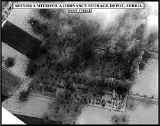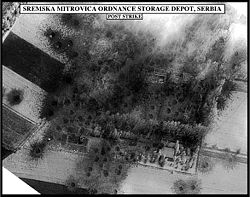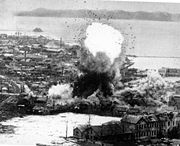
Airstrike
Encyclopedia

Military aviation
Military aviation is the use of aircraft and other flying machines for the purposes of conducting or enabling warfare, including national airlift capacity to provide logistical supply to forces stationed in a theater or along a front. Air power includes the national means of conducting such...
during an offensive mission. Air strikes are commonly delivered from aircraft such as fighter
Fighter
Fighter or The Fighter may refer to:*Warrior, a person skilled in combat*Soldier, someone in the army*Fighter aircraft, a warplane designed to destroy or damage enemy warplanes in air-to-air combatFilms...
s, bomber
Bomber
A bomber is a military aircraft designed to attack ground and sea targets, by dropping bombs on them, or – in recent years – by launching cruise missiles at them.-Classifications of bombers:...
s, ground attack aircraft
Ground attack aircraft
Ground-attack aircraft are military aircraft with primary role of attacking targets on the ground with greater precision than bombers and prepared to face stronger low-level air defense...
, attack helicopters, and others. The official definition includes all sorts of targets, including enemy air targets, but in popular use the term is usually narrowed to tactical
Tactical
-Personnel:Musicians*Deron Miller – vocals, guitar*Tim Yeung – drums*Luke Jaeger – lead guitar*Risha Eryavac - bass*James Murphy – guitar solos & bass on "Wake Up Dead"-Release details:...
(small-scale) attack on a ground or naval objective. Weapons used in an airstrike can range from machine gun
Machine gun
A machine gun is a fully automatic mounted or portable firearm, usually designed to fire rounds in quick succession from an ammunition belt or large-capacity magazine, typically at a rate of several hundred rounds per minute....
bullet
Bullet
A bullet is a projectile propelled by a firearm, sling, or air gun. Bullets do not normally contain explosives, but damage the intended target by impact and penetration...
s, missile
Missile
Though a missile may be any thrown or launched object, it colloquially almost always refers to a self-propelled guided weapon system.-Etymology:The word missile comes from the Latin verb mittere, meaning "to send"...
s, to various types of bomb
Bomb
A bomb is any of a range of explosive weapons that only rely on the exothermic reaction of an explosive material to provide an extremely sudden and violent release of energy...
s.
In close air support
Close air support
In military tactics, close air support is defined as air action by fixed or rotary winged aircraft against hostile targets that are close to friendly forces, and which requires detailed integration of each air mission with fire and movement of these forces.The determining factor for CAS is...
, air strikes are usually controlled by trained observers for coordination with friendly ground troops in a manner derived from artillery
Artillery
Originally applied to any group of infantry primarily armed with projectile weapons, artillery has over time become limited in meaning to refer only to those engines of war that operate by projection of munitions far beyond the range of effect of personal weapons...
tactics.
History

Kingdom of Italy (1861–1946)
The Kingdom of Italy was a state forged in 1861 by the unification of Italy under the influence of the Kingdom of Sardinia, which was its legal predecessor state...
aviator Second Lieutenant Giulio Gavotti
Giulio Gavotti
Giulio Gavotti was an Italian Lieutenant and pilot, who fought in the Italo-Turkish War. He set two firsts in the history of aerial warfare of heavier-than-air flyers: he was the first man to make an aerial bombardment, as well the first to perform a night mission.-Aerial bombardment:On the 1...
dropped four bombs on two Turkish-held oases
Oasis
In geography, an oasis or cienega is an isolated area of vegetation in a desert, typically surrounding a spring or similar water source...
in Libya, carrying out the world's first air strike as part of the Italo-Turkish War
Italo-Turkish War
The Italo-Turkish or Turco-Italian War was fought between the Ottoman Empire and the Kingdom of Italy from September 29, 1911 to October 18, 1912.As a result of this conflict, Italy was awarded the Ottoman provinces of Tripolitania, Fezzan, and...
.
Use of air strikes become extended in World War I
World War I
World War I , which was predominantly called the World War or the Great War from its occurrence until 1939, and the First World War or World War I thereafter, was a major war centred in Europe that began on 28 July 1914 and lasted until 11 November 1918...
. For example at the Battle of Neuve Chapelle
Battle of Neuve Chapelle
The Battles of Neuve Chapelle and Artois was a battle in the First World War. It was a British offensive in the Artois region and broke through at Neuve-Chapelle but they were unable to exploit the advantage.The battle began on 10 March 1915...
in 1915 the British Royal Flying Corps
Royal Flying Corps
The Royal Flying Corps was the over-land air arm of the British military during most of the First World War. During the early part of the war, the RFC's responsibilities were centred on support of the British Army, via artillery co-operation and photographic reconnaissance...
dropped bombs on German rail communications.
Collateral damage
.jpg)
Collateral damage
Collateral damage is damage to people or property that is unintended or incidental to the intended outcome. The phrase is prevalently used as an euphemism for civilian casualties of a military action.-Etymology:...
.
Collateral damage can be advantageous by damaging nearby enemy troops and installations. The negative side effects to collateral damage may include the infliction of damage to civilian facilities and accidental injury of friendly troops
Friendly fire
Friendly fire is inadvertent firing towards one's own or otherwise friendly forces while attempting to engage enemy forces, particularly where this results in injury or death. A death resulting from a negligent discharge is not considered friendly fire...
near the target.

